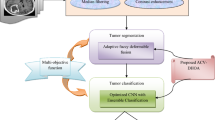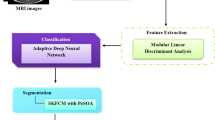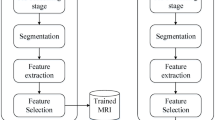Abstract
Brain tumor classification is a significant issue in Computer-Aided Diagnosis (CAD) for clinical applications. The classification process is crucial and plays a major role to diagnosis the brain tumors. The existing works focus on recognizing brain tumors through diverse classification approaches. Though, the conventional classification approaches are suffered from high false alarm rates. To improve the early-stage brain tumor diagnosis via classification, the main intention of this paper is to introduce a novel brain tumor segmentation and classification model. The dataset gathered from the two benchmark sources is subjected to pre-processing for enhancing the quality of images, and skull stripping for extracting the region of interest from the skull. Further, a new segmentation approach termed Adaptive Fuzzy Active Contour Fusion Model (AFACFM) with a new fitness function is developed. Here, the enhancement of the segmentation is performed by the hybrid Jaya-Tunicate Swarm Algorithm (J-TSA). Next, the combination of Convolutional Neural Network (CNN) and Fuzzy classifier is performed in the final classification phase. The deep features are extracted from the pooling layer of CNN, which are subjected to the Fuzzy classifier for classifying the images into normal, benign, and malignant. As a modification, the parameters of the CNN and Fuzzy classifier are tuned by the proposed J-TSA. The comparative analysis is finally done, and this work demonstrates the potential of using deep learning in MRI images to provide a non-invasive tool for simultaneous and automated tumor segmentation and classification. Through the performance analysis, the accuracy of the designed CNN-Fuzzy using J-TSA was 77%, 29%, 19%, 8.7%, 6.8%, and 1.6% enhanced than SVM, NN, DBN, CNN, Fuzzy, and CNN-Fuzzy, respectively.


















Similar content being viewed by others
References
Abd-Ellah MK, Awad AI, Khalaf AAM, Hamed HFA (2018) Two-phase multi-model automatic brain tumour diagnosis system from magnetic resonance images using convolutional neural networks. EURASIP J Image Video Process 97
Ali M, Gilani SO, Waris A, Zafar K, Jamil M (2020) Brain tumour image segmentation using deep networks. IEEE Access 8:153589–153598
Arakeri MP, Reddy GRM (2013) An intelligent content-based image retrieval system for clinical decision support in brain tumor diagnosis. Int J Multimedia Inform Retrieval 2:175–188
Ayadi W, Elhamzi W, Charfi I, Atri M (2021) Deep CNN for Brain Tumor Classification. Neural Processing Letters 53:671–700
Bhattacharyya D, Kim TH (2011) Brain tumor detection using MRI image analysis. Comm Com Inform Sci 151:307–314
Biji CL, Selvathi D, Panicker A (2011) Tumor detection in brain magnetic resonance images using modified thresholding techniques. Comm Comp Inform Sci 4:300–308
Chen B, Zhang L, Chen H, Liang K, Chen X (2021) A novel extended Kalman filter with support vector machine based method for the automatic diagnosis and segmentation of brain tumors. Comp Methods Programs Biomed 200:105797
Cruz-Aceves I, Avina-Cervantes JG, Lopez-Hernandez JM, Garcia-Hernandez MG, Torres-Cisneros M, Estrada-Garcia HJ, Hernandez-Aguirre A (2013) Automatic image segmentation using active contours with univariate marginal distribution. Math Probl Eng 2013:1–9
Deng W, Shi Q, Wang M, Zheng B, Ning N (2020) Deep learning-based HCNN and CRF-RRNN model for brain tumor segmentation. IEEE Access 8:26665–26675
Eugenio Iglesias J, Rory Sabuncu M, Van Leemput K (2013) A unified framework for cross-modality multi-atlas segmentation of brain MRI. Med Image Anal 17(8):1181–1191
Fernández-Navarro F, Carbonero-Ruz M, Becerra Alonso D, Torres-Jiménez M (2017) Global sensitivity estimates for neural network classifiers. IEEE Trans Neural Networks Learn Syst 28(11):2592–2604
Sepehr Salem Ghahfarrokhi and Hamed Khodadadi "Human brain tumor diagnosis using the combination of the complexity measures and texture features through magnetic resonance image," Biomed Signal Processing and Control, Vol. 61, August 2020.
Gooya A, Biros G, Davatzikos C (2011) Deformable registration of glioma images using em algorithm and diffusion reaction modeling. IEEE Trans Med Imaging 30(2):375–390
Huang M, Yang W, Wu Y, Jiang J, Chen W, Feng Q (2014) Brain tumor segmentation based on local independent projection-based classification. IEEE Trans Biomed Eng 61(10):2633–2645
Huang Z, Xiaohao D, Chen L, Li Y, Liu M, Chou Y, Jin L (2020) Convolutional neural network based on complex networks for brain tumor image classification with a modified activation function. IEEE Access 8:89281–89290
Emrah Irmak, multi-classification of brain tumor MRI images using deep convolutional neural network with fully optimized framework, Iranian J Sci Techn, Trans Electrical Eng, 2021.
Islam K, Ali S, Miah S, Rahman M, Alam S, Hossain MA (2021) Brain tumor detection in MR image using superpixels, principal component analysis and template based K-means clustering algorithm. Mach Learning Appl 5:15
Satnam Kaur, Lalit K. Awasthi, A.L. Sangal, and Gaurav Dhiman, "Tunicate Swarm Algorithm: A new bio-inspired based metaheuristic paradigm for global optimization", Eng Appl Artif Intell, Volume 90, April 2020.
Khosravanian A, Rahmanimanesh M, Keshavarzi P, Mozaffari S (2021) Fast level set method for glioma brain tumor segmentation based on Superpixel fuzzy clustering and lattice Boltzmann method. Comp Methods Programs Biomed 198:105809
Kumar A, Ramachandran M, Gandomi AH, Patan R, Lukasik S, Soundarapandian RK (2019) A deep neural network based classifier for brain tumor diagnosis. Appl Soft Comput 82:105528
Tarun Kumar and Karun Verma "A Theory Based on Conversion of RGB image to Gray image," Int J Comp Appl, vol. 7, issue. 2, September 2010.
Lee H, Lee DS, Kang H, Kim BN, Chung MK (2011) Sparse brain network recovery under compressed sensing. IEEE Trans Med Imaging 30(5):1154–1165
Ma C, Luo G, Wang K (2018) Concatenated and connected random forests with multiscale patch driven active contour model for automated brain tumor segmentation of MR images. IEEE Trans Med Imaging 37(8):1943–1954
Masood M, Nazir T, Nawaz M, Javed A, Iqbal M, Mehmood A (2021) Brain tumor localization and segmentation using mask RCNN. Front Comp Sci 15:156338
Menaga D, Revathi S (2020) An empirical study of cancer classification techniques based on the neural networks. Biomed Eng: Appl, Basis Comm 32(02):2050013 (10 pages)
Menaga D. and Revathi S."Probabilistic Principal Component Analysis (PPCA) Based Dimensionality Reduction and Deep Learning for Cancer Classification,"Intell Comp Appl ,pp 353–368,30 September 2020.
Menze BH, Jakab A, Bauer S, Kalpathy-Cramer J, Farahani K, Kirby J, Burren Y, Porz N, Slotboom J, Wiest R (2014) The multimodal brain tumor image segmentation benchmark (BRATS). IEEE Trans Med Imaging
Mirjalili S, Mirjalili SM, Hatamlou A (2016) Multi-verse optimizer: a nature-inspired algorithm for global optimization. Neural Comput & Applic 27:495–513
Noreen N, Palaniappan S, Qayyum A, Ahmad I, Imran M, Shoaib M (2020) A deep learning model based on concatenation approach for the diagnosis of brain tumor. IEEE Access 8:55135–55144
Palanisamy K, Prasath S (2015) Methods on Skull Stripping of MRI Head Scan Images—a Review. J Digital Imaging 29(3)
Pereira S, Pinto A, Alves V, Silva CA (2016) Brain tumor segmentation using convolutional neural networks in MRI images. IEEE Trans Med Imaging 35(5):1240–1251
Price SR, Price SR, Anderson DT (2019) Introducing Fuzzy Layers for Deep Learning. IEEE International Conference on Fuzzy Systems (FUZZ-IEEE):1–6
Razzak MI, Imran M, Xu G (2019) Efficient brain tumor segmentation with multiscale two-pathway-group conventional neural networks. IEEE J Biomed Health Inform 23(5):1911–1919
Senthilkumaran and Vaithegi, "Image Segmentation by using Thresholding Techniques for Medical Images," Comp Sci Eng: Int J (CSEIJ), Vol.6, No.1, February 2016.
Serta E, Özyurt F, Doğantekin A (2019) A new approach for brain tumor diagnosis system: single image super resolution based maximum fuzzy entropy segmentation and convolutional neural network. Med Hypotheses 133:109413
Shi Q, Yin S, Wang K, Lin T, Li H (2021) Multichannel convolutional neural network-based fuzzy active contour model for medical image segmentation. Evolving Syst
Sultan HH, Salem NM, Al-Atabany W (2019) Multi-classification of brain tumor images using deep neural network. IEEE Access 7:69215–69225
Venkata Rao R (2016) Jaya: a simple and new optimization algorithm for solving constrained and unconstrained optimization problems. Int J Ind Eng Comput 7:19–34
Wang H, Suh JW, Das SR, Pluta J, Craige C, Yushkevich PA (2013) Multi-atlas segmentation with joint label fusion. IEEE Trans Pattern Anal Mach Intell 35(3):611–623
Wang L, Zhang J, Liu Y, Mi J, Zhang J (2021) Multimodal medical image fusion based on Gabor representation combination of multi-CNN and fuzzy neural network. IEEE Access 9:67634–67647
Wright J, Yang AY, Ganesh A, Sastry SS, Ma Y (2009) Robust face recognition via sparse representation. IEEE Trans Pattern Anal Mach Intell 31(2):210–227
Yeganejou M, Dick S (2019) Improved Deep Fuzzy Clustering for Accurate and Interpretable Classifiers. IEEE Int Conf Fuzzy Syst (FUZZ-IEEE):1–7
Zhang J, Jiang Z, Dong J, Hou Y, Liu B (2020) Attention gate ResU-net for automatic MRI brain tumor segmentation. IEEE Access 8:58533–58545
Zhang S, Zhan Y, Metaxas DN (2012) Deformable segmentation via sparse representation and dictionary learning. Med Image Anal 16(7):1385–1396
Zhong P, Gong Z, Li S, Schönlieb C (2017) Learning to diversify deep belief networks for hyperspectral image classification. IEEE Trans Geosci Remote Sens 55(6):3516–3530
Zhou Y, Chen H, Li Y, Liu Q, Xu X, Wang S, Yap P-T, Shen D (2021) Multi-task learning for segmentation and classification of tumors in 3D automated breast ultrasound images. Med Image Anal 70:101918
Zhu Y, Cheng H (2012) An improved median filtering algorithm for image noise reduction. Phys Procedia 25:609–616
Funding
This research did not receive any specific funding.
Author information
Authors and Affiliations
Corresponding author
Ethics declarations
Conflict of interest
The authors declare no conflict of interest.
Additional information
Publisher’s note
Springer Nature remains neutral with regard to jurisdictional claims in published maps and institutional affiliations.
Rights and permissions
About this article
Cite this article
Kumar, K.A., Boda, R. A computer-aided brain tumor diagnosis by adaptive fuzzy active contour fusion model and deep fuzzy classifier. Multimed Tools Appl 81, 25405–25441 (2022). https://doi.org/10.1007/s11042-022-12213-7
Received:
Revised:
Accepted:
Published:
Issue Date:
DOI: https://doi.org/10.1007/s11042-022-12213-7




